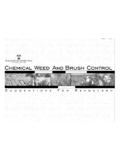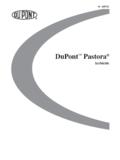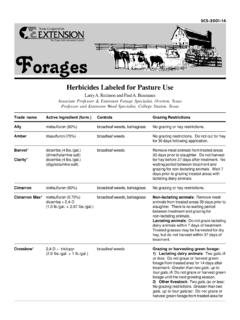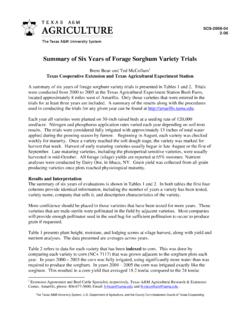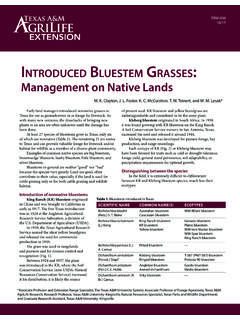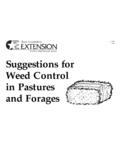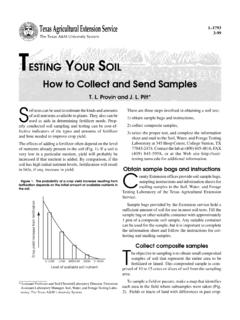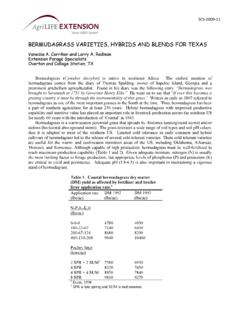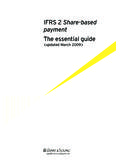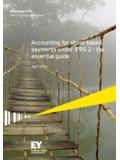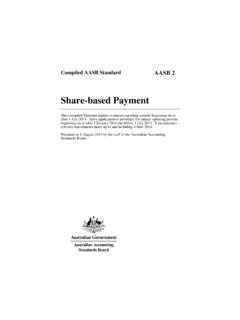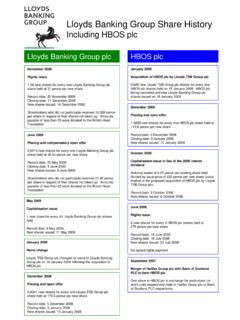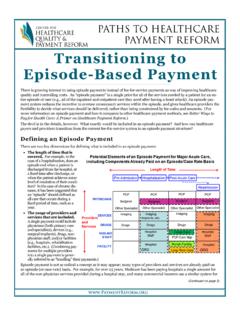Transcription of COST SHARE PROGRAMS SCS - Texas Forages
1 SCS 2010 12. COST SHARE AND TECHNICAL ASSISTANCE PROGRAMS FOR IMPLEMENTING BEST MANAGEMENT PRACTICES TO IMPROVE WATER QUALITY Jennifer L. Peterson, Program Specialist, Water Quality Larry A. Redmon, Professor and State Forage Specialist More than 90% of the land in Texas is privately owned. As a result, the primary responsibility for environmental stewardship and protection of the state's critical land and water resources falls upon private landowners. Fortunately, several state and federally funded cost SHARE assistance PROGRAMS are available to off set associated expenses. Cost sharing is a process whereby payments are made to landowners to cover a portion of the costs associated with installation and/or management of structural and non structural practices that help protect the environment (known as Best Management Practices or BMPs). Cost SHARE rates typically range from 40 to 75 percent, but can be as high as 90 percent. In addition, several state and federal agencies also provide technical assistance, including planning and engineering design, to support private landowners interested in installing BMPs on their property.
2 Below is a brief description of the primary state and federal cost SHARE assistance PROGRAMS available to landowners in Texas , along with links to program websites and contact information for each responsible agency. STATE PROGRAMS : Texas Parks and Wildlife Department (TPWD) Texas Landowner Incentive Program (LIP): A voluntary program designed to assist private landowners wishing to implement natural resource conservation practices on their land. Focuses on projects aimed at creating, restoring, protecting, and enhancing habitat for rare or at risk species throughout the state, as well as activities that positively impact valuable riparian areas and watersheds. Technical assistance for plan development is available through the TPWD. Pays up to 75 percent of the cost of installing an eligible conservation practice; applicant is expected to contribute a minimum of 25 percent non federal match (in kind labor, materials, etc.). Projects showing the greatest benefit to targeted species receive priority, as do projects offering long term protection, long term monitoring and greater than 25 percent landowner contribution.
3 Participants enroll in LIP contracts lasting between 1 and 3 years. There are no acreage restrictions. For more information, visit: Texas State Soil and Water Conservation Board (TSSWCB) Water Quality Management Plan Program (WQMP): The WQMP Program is a voluntary program available to landowners. A WQMP is a site specific plan for agricultural or silvicultural (forest) lands developed through and approved by local Soil and Water Conservation Districts (SWCDs). The WQMP includes discussion and implementation timelines for appropriate BMPs ( , treatment practices, production practices, management measures, technologies, or combinations thereof). These practices are selected based on the standards outlined in the Department of Agriculture Natural Resources Conservation Service (NRCS) Field Office Technical Guide (FOTG). A successful plan will achieve a level of pollution prevention or abatement determined by the TSSWCB in consultation with your SWCD to be consistent with state water quality standards.
4 Technical assistance for plan development is available through your SWCD. Cost SHARE assistance up to 75 percent of the cost of implementing selected BMPs is available from the TSSWCB through your SWCD. For more information, visit: Comprehensive Nutrient Management Plan Program (CNMP): Program is confined to North Bosque River Watershed (Cross Timbers SWCD and Upper Leon SWCD) and deals only with animal feeding operations (AFOs) and confined animal feeding operations (CAFOs); no other animal feeding operations in the state are required by law to have a CNMP (for definitions see ). A CNMP is a plan that addresses all aspects of an animal feeding operation through a grouping of conservation practices and management activities that, when implemented, will ensure that both production and natural resource protection goals are achieved. A CNMP should identify and address natural resource concerns with regard to soil, water, air, plants, animals, and people on the farm. Producers who receive TSSWCB certification of their CNMP may be eligible for cost SHARE assistance through their local SWCD.
5 For more information, visit: FEDERAL PROGRAMS : Farm Services Agency (FSA) Conservation Reserve Program (CRP): A voluntary program for agricultural landowners that provides annual rental payments and cost . SHARE assistance to establish long term, resource conserving covers on eligible farmland. The Commodity Credit Corporation (CCC) makes annual rental payments based on the agriculture rental value of the land, and provides cost SHARE assistance for up to 50 percent of the participant's costs in establishing approved conservation practices. Rental payments are generally $30 $40/acre during each year of the contract and landowners can receive additional incentive payments above 50 percent for certain conservation practices. Participants enroll in CRP contracts for 10 to 15 years. 2 CRP has protected millions of acres of topsoil from erosion, protected groundwater supplies, and has improved the condition of lakes, rivers, ponds, and streams nationwide. The program has likewise provided millions of acres of enhanced wildlife habitat.
6 Texas currently has more than 4 million acres enrolled in CRP. For more information, visit: Continuous Conservation Reserve Program (CCRP): A voluntary program that focuses on using grasses, trees, and wetlands to protect soil, improve air and water quality, and enhance fish and wildlife habitat through the use of buffers, filter strips, windbreaks, and wildlife corridors. Participants enroll in CCRP contracts for 10 to 15 years. Program provides a signup incentive payment of $100 $150/acre and 50 percent cost SHARE on qualifying practices, with an additional 40 percent paid upon timely completion. Program also provides an annual rental payment of $30 $40/acre over the life of the contract. For more information, visit: Natural Resources Conservation Service (NRCS) Environmental Quality Incentives Program (EQIP): A voluntary conservation program for farmers, ranchers, and owners of private, non industrial forestland that provides financial and technical assistance to install or implement conservation practices.
7 Eligible land includes cropland, rangeland, pastureland, private non industrial forestland, and other lands as determined by the USDA Secretary of Agriculture. Program offers contracts with a minimum term that ends 1 year after the implementation of the last scheduled practice(s) and a maximum term of 10 years. Except in limited circumstances, cost SHARE cannot exceed $300,000 per individual. Program pays up to 75 percent of the cost of installing eligible conservation practices; limited resource and beginning farmers may be eligible for up to 90 percent cost SHARE . For more information, visit: Agricultural Water Enhancement Program (AWEP): A component of EQIP that provides financial and technical assistance to agricultural producers to implement water enhancement activities on agricultural land for the purposes of conserving surface and ground water and improving water quality. Owners and operators engaged in livestock or agricultural production may be eligible for the program.
8 Eligible land includes cropland, rangeland, pasture, private non industrial forestland, and other farm or ranchland. NRCS enters into partnership agreements with eligible entities and organizations that want to promote ground and surface water conservation or improve water quality on agricultural lands. Like EQIP, contract terms are from 1 to 10 years in duration. For more information, visit: 3 Conservation Stewardship Program (CSP): A voluntary program for agricultural landowners that offers technical and financial assistance to farmers for maintaining high standards of environmental stewardship. Assistance is available both for active management of existing conservation systems and implementation of new conservation activities on land in agricultural production. Eligible lands include cropland, grassland, prairieland, improved pastureland, rangeland, non . industrial private forestland and agricultural land under tribal jurisdiction. Participants enroll in CSP contracts for 5 years with the option to renew for another 5 years.
9 Program has a payment cap of $200,000 per contract period (5 years). Payments include planning, installation, improvement and maintenance of conservation activities, forgone income, and expected environmental benefits. For more information, visit: Conservation Technical Assistance (CTA): A voluntary technical assistance program available to any group or individual interested in conserving natural resources and sustaining agricultural production. Program helps landowners address opportunities, concerns, and problems related to the use of natural resources and helps in decision making regarding natural resource management. Technical assistance may be in the form of resource assessment, practice design, resource monitoring, or follow up on installed practices. For more information, visit: Wildlife Habitat Incentive Program (WHIP): A voluntary program for developing or improving high quality habitat that supports fish and wildlife populations. Provides technical and financial assistance to private and Tribal landowners for the development of upland, wetland, aquatic, and other types of habitat.
10 Eligible land includes cropland, grassland, rangeland, pasture, and other land determined by the NRCS to be suitable for fish and wildlife habitat development. Program offers contracts with a minimum term that ends 1 year after the implementation of the last scheduled practice(s) and a maximum term of 10 years. Program pays up to 75 percent of the cost of installing eligible conservation practices; limited resource and beginning farmers may be eligible for increased cost SHARE payments. Long term cost SHARE agreements lasting 15 years or longer are also possible in certain situations; in this instance, NRCS can pay up to 90 percent of the cost to install conservation practices. For more information, visit: Wetland Reserve Program (WRP): A voluntary program that provides technical and financial assistance to eligible landowners to address wetland, wildlife habitat, soil, water, and related natural resource concerns on private lands in an environmentally beneficial and cost effective manner.
